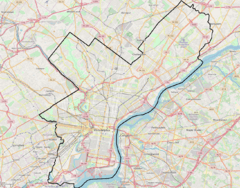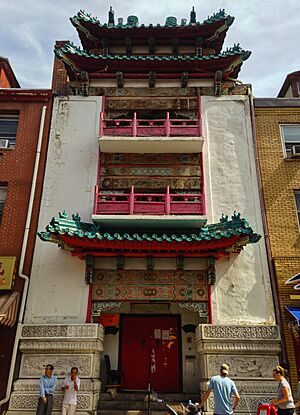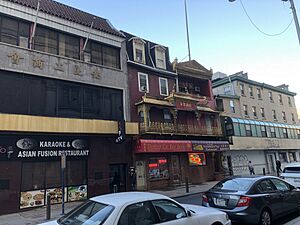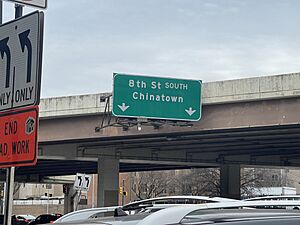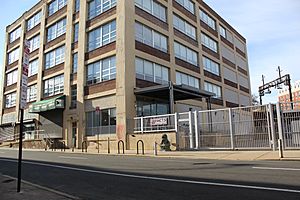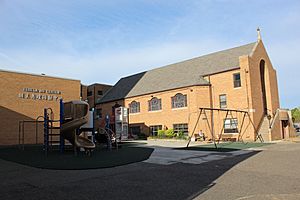Chinatown, Philadelphia facts for kids
Quick facts for kids
Chinatown
|
|
|---|---|

A Chinese "Friendship Arch" at 10th and Arch streets in Philadelphia
|
|
| Country | |
| State | Pennsylvania |
| County | Philadelphia |
| City | Philadelphia |
| ZIP Code |
19107
|
| Area code(s) | 215, 267, and 445 |
Philadelphia Chinatown is a lively neighborhood in the heart of Philadelphia, Pennsylvania. A group called the Philadelphia Chinatown Development Corporation helps support and improve the area. It stretches from Vine Street in the north to Arch Street in the south. On the east, it reaches North Franklin Street and N. 7th Street, and on the west, it extends to North Broad Street.
Unlike some older Chinatowns, Philadelphia's Chinatown is still growing. More and more people from China are moving to Philadelphia, including many from New York City. Since the 1980s, Chinatown has also welcomed people and businesses from other Asian countries. You can find Vietnamese, Cambodian, Japanese, Korean, Malaysian, and Indonesian communities here. <mapframe latitude="39.960017" longitude="-75.155582" zoom="13" width="301" height="250" align="right"> { "type": "FeatureCollection", "features": [ { "type": "Feature", "properties": {}, "geometry": { "type": "Polygon", "coordinates": [ [ [ -75.16242092417089, 39.952248157291706 ], [ -75.1504029723583, 39.950767987495524 ], [ -75.1491824781988, 39.95630125684115 ], [ -75.15256105049049, 39.95679142570614 ], [ -75.16230271576207, 39.957922282638194 ], [ -75.16334340238247, 39.953408068414724 ], [ -75.16249905922452, 39.95335828043478 ], [ -75.16242092417089, 39.952248157291706 ] ] ] } } ] } </mapframe>
Contents
History of Philadelphia's Chinatown
How Chinatown Began in the 1800s
Philadelphia's Chinatown started because many Chinese Americans moved east. This happened after the first transcontinental railroad was finished in 1869. Life became difficult for Chinese workers in the American West. Many moved to cities like Philadelphia to find new opportunities.
The first Chinese immigrants to Philadelphia were mostly young men. They came seeking work and often left their families behind in China. In Chinatown, they found support and built communities with relatives and cultural groups. A law called the Chinese Exclusion Act in 1882 made it even harder for families to join them. It also stopped them from becoming U.S. citizens.
In Philadelphia, Chinese men were often not allowed to work in factories. So, they opened laundries and restaurants. These businesses were near the city's busy docks. This is how Philadelphia's Chinatown began. The very first business was a laundry opened by Lee Fong in 1871 on Race Street.
Chinatown in the 1900s
For many years, Chinatown was a small area around the 900 block of Race Street. It had a few restaurants and one grocery store until the mid-1960s.
In the mid-1960s, more families started moving into Chinatown. However, parts of Chinatown were torn down for new projects. These included the Vine Street Expressway and the Pennsylvania Convention Center. To protect the community, the Philadelphia Chinatown Development Corporation was formed in 1968. This group helped local leaders have a say in new building plans.
In the late 1990s, the Philadelphia Phillies baseball team wanted to build a new stadium. One idea was near 12th and Vine Streets, close to Chinatown. The Philadelphia Chinatown Development Corporation strongly opposed this plan. Residents worried the stadium would destroy their neighborhood. The PCDC organized protests and brought many groups together. In the end, the Phillies built Citizens Bank Park elsewhere.
Around 1998, businesses from other Asian countries also opened in Chinatown. These included places from Korea, Thailand, and Vietnam. By 1998, community leaders also started building a new housing complex called Hing Wah Yuen.
Chinatown in the 2000s
In 2012, a plan for a new community center was approved. It was first called the Eastern Tower Community Center. Later, it was renamed "Crane Chinatown" in 2018. Construction started in 2017, and it officially opened in November 2019. This center is an important part of the community.
Chinatown's Layout and Boundaries
Vine Street marks the northern edge of Chinatown. South of Vine Street, you'll find restaurants and shops, often with apartments above them. Factories are located on the other side of Vine Street. Filbert Street is the southern border. The main part of Chinatown covers about seven city blocks. Many people living here in 1998 were new immigrants.
Over the years, new buildings and roads shaped Chinatown's current size. In the 1920s, ramps for the Benjamin Franklin Bridge were built at its northern side. Later, the city took land east of Chinatown for new buildings. These included the Philadelphia Police Department headquarters and Independence Mall. In 2004, a former hospital in the area became fancy apartments.
At one point, there was a plan for a large highway that would cut Chinatown in half. It would have removed the Holy Redeemer Church and School. But the community fought back. The church and school stayed, and the Vine Street Expressway was built smaller. Cecelia Yep, a community leader, said it felt like "a fight for survival."
The construction of the Market East Station in the 1970s and 1980s set Filbert Street as Chinatown's southern border. When the Pennsylvania Convention Center opened in 1993, buildings on Arch Street were torn down. A federal prison, the Federal Detention Center, Philadelphia, also opened nearby. These large projects now surround Chinatown's core area.
 |
Spring Garden | Callowhill | Franklin Square |  |
| Pennsylvania Convention Center | Independence Mall | |||
| Market East | Market East | Old City |
Who Lives in Chinatown?
| Historical population | |||
|---|---|---|---|
| Census | Pop. | %± | |
| 1990 | 1,096 | — | |
| 2000 | 1,421 | 29.7% | |
| 2010 | 2,464 | 73.4% | |
| Asian American population | |||
In 2000, the area served by the Philadelphia Chinatown Development Corporation had 1,362 residents. Most of them (1,085) were Asian American. There were also people who were White American, African American, and Hispanic American.
In 1998, the wider Chinatown area had about 4,000 residents. Many worked in clothing factories, restaurants, and related businesses. Most residents were Chinese American. In 1990, the average income in Chinatown was lower than in other parts of Center City Philadelphia. In 2000, about 70% of the residents in the wider area did not speak English fluently.
The Philadelphia Chinatown Development Corporation also notes that the area serves about 250,000 Chinese Americans. These people live in Delaware, New Jersey, and Pennsylvania. Many Fuzhounese and other Chinese Americans are moving to Philadelphia from New York City.
Famous Landmarks in Chinatown
The Chinatown Friendship Gate is a special landmark at 10th and Arch Street. It stands for the friendship between Philadelphia and its Chinese sister city, Tianjin. The Gate was planned in 1982 and finished in 1984.
This Gate was the first real Chinese Gate built in America by artists from China. It weighs about 88 tons and is 40 feet tall. Its bright colors and detailed designs show old Chinese building styles. It features mythical creatures and patterns from the Ming and Qing Dynasties. A phoenix is meant to bring good luck. A dragon, believed to hold water, is there to protect the Gate and the community from fire. The Chinese words on the Gate mean "Philadelphia Chinatown."
The Gate was repainted in 2008 by Tianjin artists using old methods. The City of Philadelphia and the Philadelphia Chinatown Development Corporation helped pay for it. It was rededicated on November 19, 2008.
Delicious Food in Chinatown
Chinatown is famous for its many East Asian restaurants. On 10th Street and Race Street, you can find nearly a dozen Hong Kong-style bakeries. There are also restaurants serving Cantonese, Fujianese, Northern, Sichuan, and Taiwanese food.
Beyond Chinese food, many places in Philadelphia's Chinatown offer other Asian cuisines. You can try Burmese, Japanese, Korean, and Vietnamese dishes.
Getting Around Chinatown
The Chinatown subway station is at 8th and Vine streets. Jefferson Station, a train station for regional lines, is just one block from the Chinatown Friendship Gate. SEPTA also provides local bus service to the area.
At one time, China Airlines offered a free bus service. It went from the Holy Redeemer Church in Chinatown to John F. Kennedy International Airport in New York City. This helped passengers get to their flights to Taipei, Taiwan.
Education in Chinatown
Schools for Kids and Teens
Public Schools
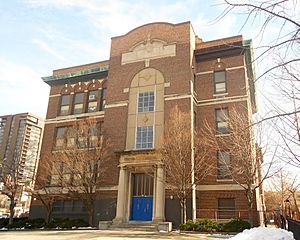
The School District of Philadelphia runs the public schools in the area. Many children from Chinatown go to General George A. McCall School. This school is for grades K-8 and is about 1 mile south of Chinatown in Society Hill. In 2005, most Chinatown families who couldn't afford private school sent their children to McCall.
Students who go to McCall later attend Benjamin Franklin High School in North Philadelphia.
The Folk Arts-Cultural Treasures Charter School (FACTS, traditional Chinese: 民藝特許學校; simplified Chinese: 民艺特许学校; pinyin: Mín Yì Tèxǔ Xuéxiào) is a K-8 public charter school located right in Chinatown.
In 1993, the school district started a bus route between Chinatown and McCall. The school is about 1.4 miles from the farthest part of Chinatown. Parents asked for this bus because they worried about traffic dangers for their children. When the district thought about cutting the route in 1994, parents protested.
By 1998, the number of Chinese students at McCall had doubled. They made up 25% of the school's 650 students. That year, McCall started a special program for Chinese immigrant students. It hired teachers who spoke both English and Chinese to teach main subjects.
In 1998, there were no public schools actually inside Chinatown. In 2005, the city approved the creation of the FACTS charter school in Chinatown. At that time, some community groups worried it might affect enrollment at McCall and Holy Redeemer.
Private Schools
The Roman Catholic Archdiocese of Philadelphia runs Catholic schools. The Holy Redeemer Chinese Catholic Church and School was built in 1941. It was the first Chinese Catholic church in the Western Hemisphere. Historically, many Chinatown families sent their children to this school. The church and school also served as a meeting place for the community. In the 1990s, the school lost some of its playground due to the expansion of the Vine Street Expressway. In 2005, it was the only school located within Chinatown itself.
Colleges and Libraries
The closest library branch is the Independence Branch of the Free Library of Philadelphia. It is in Society Hill, about four blocks from Chinatown.
The Community College of Philadelphia system also serves the Chinatown area.
See also
 In Spanish: Chinatown (Filadelfia) para niños
In Spanish: Chinatown (Filadelfia) para niños


